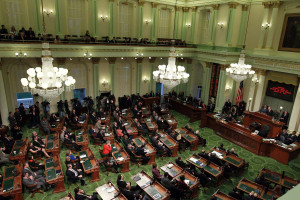By: Michael Powers
Since the real estate market crash of late 2007 and 2008, California has been the leader in legislation designed to protect homeowners and regulate the loan modification practice. Unfortunately for many California homeowners, legislative relief arrived too late and their houses were lost to foreclosure, victims of California’s rapid non-judicial foreclosure process. In addition, many homeowners lost money paying for assistance that was either fraudulent or inadequate to prevent a foreclosure. Over the past few years, however, legislative measures have served to shape California mortgage relief into what it is today. In short, there has never been a better time to resolve a troubled mortgage here in the Golden State.
During the peak of the mortgage industry, Southern California had the highest concentration of mortgage and mortgage related service companies in the nation. In 2007, it seemed like everyone I knew was somehow involved in the mortgage industry. Within a matter of months, mortgage broker shops began to fold, and underwriters, processors, title officers and administrative staff were looking for work. I recall a Sunday classified section of the San Diego Union-Tribune in November of 2007 that was no more than 3 pages of low wage jobs. Like a dried up mining town, the San Diego job market seemed to disappear when the mortgage industry crashed.
This meltdown and the subsequent mortgage crisis left two things in California; a giant mortgage mess that needed to be cleaned up, and a huge pool of labor that created it. It was quite natural that “loan modification” became the catchphrase of the day and that mortgage brokers and underwriters were drawn to the business. After all, it was a natural fit for their skill sets, and the brokers even had books of potential clients to contact. Yep, the people they had written mortgage loans for!
“Loan Modification” and “Home Rescue” companies popped up by the hundreds in California. Some with the altruistic mission of helping people in need, others out for a quick buck in the “next best thing” and a few fraudsters looking to take advantage of desperation. Regardless, it was an industry on the rise and the need for legislative regulation was obvious.
 In 2009, the California Senate passed Senate Bill 94 (SB94). It was signed into law in October of 2008, and sent the industry scrambling. The controversial law sought to protect homeowners by driving out individuals and organizations who were unable to produce results for homeowner, by banning any upfront fees for “loan modification” services, even by attorneys. It spelled out “phases” of work required to be completed prior to any fees being collected, and gave the state’s Attorney General a loose reign in monitoring and regulating service providers.
In 2009, the California Senate passed Senate Bill 94 (SB94). It was signed into law in October of 2008, and sent the industry scrambling. The controversial law sought to protect homeowners by driving out individuals and organizations who were unable to produce results for homeowner, by banning any upfront fees for “loan modification” services, even by attorneys. It spelled out “phases” of work required to be completed prior to any fees being collected, and gave the state’s Attorney General a loose reign in monitoring and regulating service providers.
The results were mixed. The Bill drove out the fraudsters, quick buck artists and the faint of heart pretty quickly. Unfortunately, it also drove out many attorneys and “loan modification” companies who were competent to perform the services and had the best of intentions. After a few years, the industry normalized as service providers conformed to legislative and regulatory requirements and lenders developed clearer program requirements and procedures.
 All the while, however, lenders held the upper hand. Though banks faced some setbacks with the “MERS” legal issues and subsequent “robo-signing” scandal, lenders were still smugly confident, since most courts had minimized the weight of RESPA and TILA violations present in the majority of mortgages, and lender participation in any mortgage relief programs was voluntary. Most of the major lenders became notorious for “losing” paperwork, giving homeowners the runaround, and some downright deceptive practices like “dual-tracking”. In the “dual-tracking” process, lenders led a homeowner to believe that they were working on a loan modification while simultaneously moving forward with the foreclosure process. Well, this process in now illegal in some states, most notably California.
All the while, however, lenders held the upper hand. Though banks faced some setbacks with the “MERS” legal issues and subsequent “robo-signing” scandal, lenders were still smugly confident, since most courts had minimized the weight of RESPA and TILA violations present in the majority of mortgages, and lender participation in any mortgage relief programs was voluntary. Most of the major lenders became notorious for “losing” paperwork, giving homeowners the runaround, and some downright deceptive practices like “dual-tracking”. In the “dual-tracking” process, lenders led a homeowner to believe that they were working on a loan modification while simultaneously moving forward with the foreclosure process. Well, this process in now illegal in some states, most notably California.
The California Homeowner Bill of Rights (HBOR) became law on January 1, 2013, and completely turned the tables in favor of homeowners. In the first Quarter of 2013, many credible sources report 70-80% declines in California foreclosures. The Bill thoroughly holds lenders and servicers accountable for every detail of the foreclosure process, so much so that it may become the pivotal chapter in ending the California foreclosure crisis. The penalties are so severe that lenders are aggressively seeking foreclosure alternatives in California. “We have never seen loan modification offers like what we are seeing today”, said Mortgage Relief Project’s Mike Amos. “Principal reductions used to be rare, whereas we pretty much expect them whenever appropriate. In addition, some borrowers have such egregious HBOR causes of action, that pursuing individual litigation finally makes sense. Some of these folks may just walk away with a great mortgage and money in their pockets!”
If you are a California homeowner seeking to resolve a troubled mortgage, there has never been a better time to take action. Most people recommend hiring an experienced foreclosure attorney. Most foreclosure attorneys offer free initial consultations and affordable payment plans, so do your homework, choose an attorney you can trust, and find out what your options are today!
Pingback: The Evolution of Loan Modification and Foreclosures in California | Direct Software News Blog | Direct Software News Blog